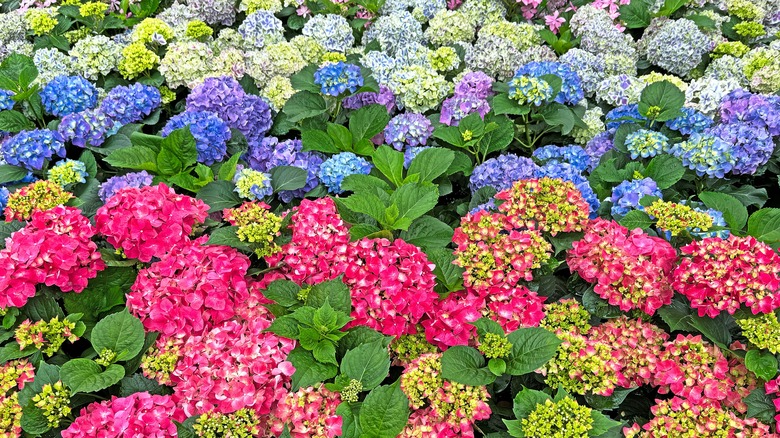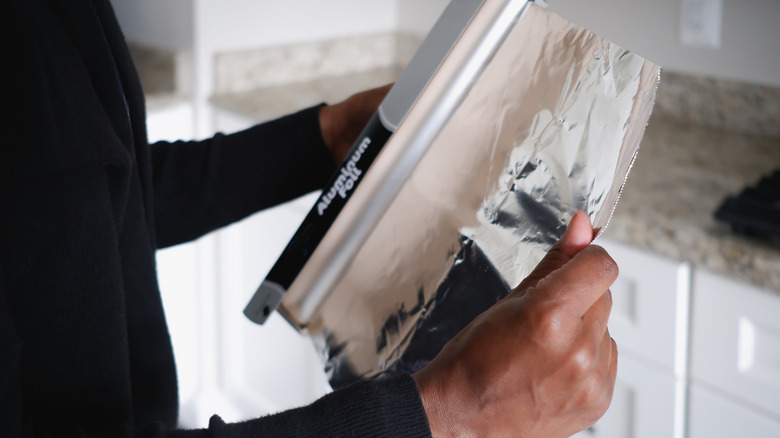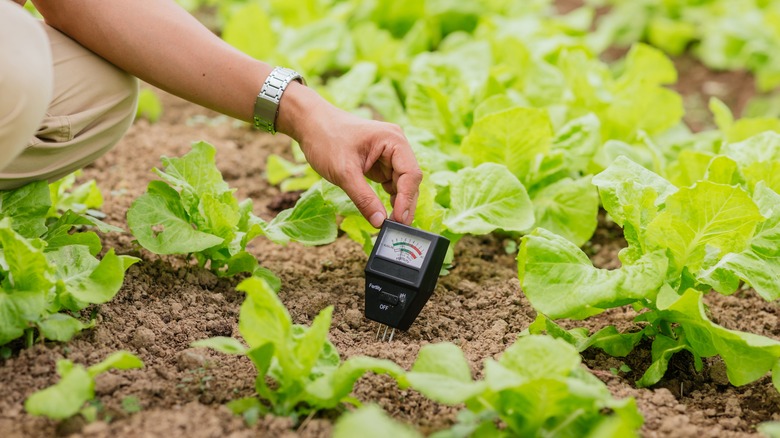Why This Aluminum Foil Color-Changing Hydrangea Trick Is A Total Bust
Hydrangeas are beloved for their lush blooms and captivating colors, but one of the most fascinating aspects of these ever-lasting garden perennials is their ability to change color. The color of a hydrangea flower, particularly the widely-cultivated bigleaf hydrangea (Hydrangea macrophylla), is primarily determined by the pH level of its soil. This is because the soil's pH affects the plants' ability to absorb aluminum ions — a key factor in the color shift. As such, whether its blooms will be blue, pink or somewhere in between, depends on this interaction between soil pH and aluminum absorption.
In the quest for achieving the perfect shade of hydrangeas, various myths and home remedies have surfaced, with one of the most persistent being the idea that burying aluminum foil near your hydrangeas will magically change their color. At first glance, this seems logical — after all, aluminum is a critical component in the color change. However, this trick doesn't work. Let's delve into why.
The myth of aluminum foil
The idea behind the aluminum foil trick likely stems from a misunderstanding of the role of aluminum in soil chemistry. To understand why this myth is flawed, it's important to first clarify how soil pH and aluminum interact to affect hydrangea color. In general, acidic soil with a pH of 5.5 or lower allows hydrangeas to absorb more aluminum, resulting in blue or purple blooms. Conversely, in neutral to alkaline soil with a pH of 6,0 or higher, aluminum becomes less available and the flowers turn pink or red.
Given this understanding, it's clear that manipulating soil pH and aluminum availability is the key to controlling hydrangea colors. However, here's where the aluminum foil trick falls apart: simply adding aluminum isn't enough — it must be in a form that the plant can absorb.
Aluminum foil is made of metallic aluminum, which is highly stable and insoluble in soil. This means it will not break down or react with the soil in a way that would make aluminum available to the hydrangea. Even if the aluminum foil were to break down over time (which it won't in any reasonable gardening timeframe), the aluminum would still not be in a form that the plant can use.
How can you change hydrangea color with aluminum?
If you're looking to change the color of your hydrangeas with aluminum, use aluminum sulfate. This is a form of aluminum that dissolves in water, releasing aluminum ions into the soil, which the hydrangea roots can then absorb. Aluminum and sulfate work together to lower the soil pH, further facilitating the absorption of aluminum by the plant. By creating a more acidic environment, you'll encourage brilliant blue booms on your hydrangeas. To turn your hydrangeas pink, however, aluminum is not the answer. This is because the goal is to reduce aluminum availability and make the soil more alkaline. Instead, the most common amendment to raise soil pH is calcium carbonate or lime.
It's also important to remember that not all hydrangea types can change color. Typically, only the bigleaf and mountain (Hydrangea serrata) varieties are capable of doing so. Make sure you know the type of hydrangea you're working with before altering your soil.
Over time, it is important to test your soil's pH to track any changes. You can do this by using a soil pH testing kit. Regular monitoring and adjustments will help maintain the desired soil conditions. By sticking with proven methods backed by science, you can save your aluminum foil for when it's truly handy — like camping or banishing birds from your fruit trees, and your hydrangeas will reward you with the vibrant colors you're aiming for.


